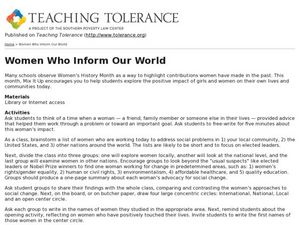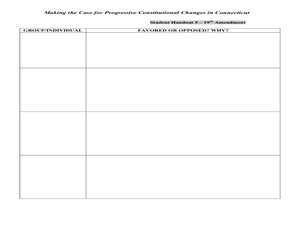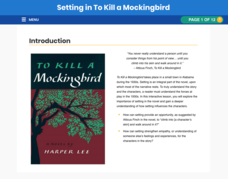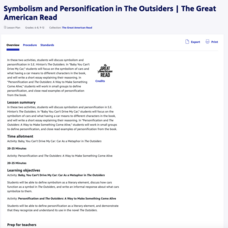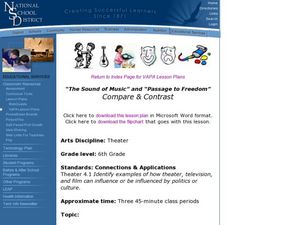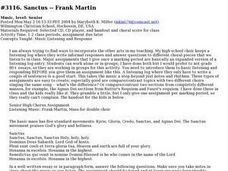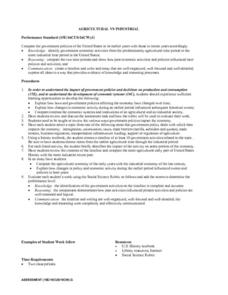Curated OER
The Ultimate Sacrifice
Learners explore the concept of sacrifice during wartime. In this World War II lesson, students explore the Allied and Axis Powers that existed during the war. Learners discover sacrifices that were made by both powers during the war as...
Curated OER
Women Who Inform Our World
Students examine the contributions of women on the international, national, and local platforms. For this writing skills lesson, students analyze a quote from Eleanor Roosevelt and compose essays that reveal how women advocate for social...
Curated OER
Our Eye in the Sky: The TIROS Weather Satellite
Students investigate the political context of the creation of a weather satellite. In this technology and society lesson, students explore the historical, technological, and political context of the TIROS weather satellite. They write a...
Curated OER
How Tragic!
Students study and interpret a classical tragedy and role play a character from the play. In this tragedy lesson, students discuss a specific work to discover the form, structure, and characteristics of the genre and interpret the...
Curated OER
Making the Case for Progressive Constitutional Changes in Connecticut
Students take a closer look at Constitutional Amendments. In this Progressive Era lesson, students discover how the amendment process works and then examine 4 amendments proposed during the era in Connecticut. Students research primary...
Curated OER
Antigone Questions
In this reading comprehension worksheet, students respond to 6 short answer and essay questions based on Antigone by Sophocles.
Curated OER
Do Not Go Gentle into That Good Night Questions
In this reading comprehension worksheet, students respond to 5 short answer and essay questions based on the poem "Do Not Go Gentle into That Good Night."
Novelinks
The Devil’s Arithmetic: Semantic Feature Analysis
Organize the characters in Jane Yolen's The Devil's Arithmetic according to their shared character traits. After listing character traits as a class, kids note which characters exhibit particular characteristics with a discussion and...
Curated OER
What Death Brings to Life - English Component
Learners are introduced to the characteristics of ancient Indian, Chinese and Aztec cultures. They consider what was valued by these cultures and compare the cultures' values to their own. They write an essay on their reflections.
Curated OER
The Wild Life: Writing Exercise
In this description worksheet, students describe a typical summer morning in a teepee village. Essays should include introductory paragraph, body paragraph, and concluding paragraph.
Curated OER
The Metamorphosis: Multicultural Strategy
Track the changes and developments in Franz Kafka's The Metamorphosis with a reading comprehension worksheet. Individuals copy important quotations from each of the book's three parts, record their reactions, and then reflect on the...
Great Books Foundation
Rattlesnakes
John Muir may be a friend to the natural world, but as a short reading passage confirms, he is no friend to rattlesnakes. As young readers learn about Muir's encounters with the dangerous creatures, they answer four comprehension...
PBS
Setting in To Kill a Mockingbird
Can you understand more about how a person acts by learning about how that person lives? An interactive resource explores the setting of Harper Lee's To Kill a Mockingbird with several slides discussing the location, social conditions,...
PBS
Symbolism and Personification in The Outsiders
A shirt can't really swallow you—right? Readers find examples of symbolism and personification in S.E. Hinton's The Outsiders with two straightforward lessons.
Curated OER
Recap and Activities (Reveloutionary War Era)
Eighth graders discuss the importance of the Second Continental Congress. They compare and contrast present-day athletic mascots and their roots in the Revolutionary War. After discussing Loyalists and Patriots, 8th graders write...
Curated OER
The Sound of Music and Passage to Freedom
Seventh graders examine music examples to investigate a conflict in history about Hitler's invasions during WWII. In this music analysis lesson, 7th graders discuss vocabulary and the history for the Holocaust and Hitler's invasions....
Curated OER
Feudalism and the Magna Carta
Young scholars compare the Magna Carta and the Bill of Rights. In this historical comparison lesson, students examine primary sources of three significant historical documents. Young scholars create a chart in a compare and contrast...
Curated OER
Hello, How Do You Do?
Students role play proper greetings and etiquette in formal and informal work and social situations. Students compare and contrast introductions and conversational conventions in their native country and in the United States by writing...
Curated OER
Crane, London, and Literary Naturalism
Students identify the key characteristics that comprise American literary naturalism in Jack London's "To Build a Fire" and Stephen Crane's "The Open Boat." In this naturalism analysis activity, students identify characteristics of the...
Curated OER
Performances of Lear's Speeches
Students engage in a activity which gives them an introduction to the text, as a way to compare and contrast the activity learned at the end of the play. They utilize worksheets imbedded in this plan to interpret what Lear is saying.
Curated OER
Sanctus--Frank Martin
Twelfth graders complete a music listening log and then work in small groups to complete essays that answer a given set of questions about the music.
Curated OER
Political Traditions
Students compare and contrast the political institutions in Greece, Rome, and the United States. In groups, they take this information to determine the influences on James Madison when organizing the republic. They develop a chart and...
Curated OER
Agricultural and Industrial Policies of the U.S.
Students examine the impact of laws and government policies on the agricultural and industrial economic systems. From a list of topics, they select one area and create timelines of at least ten related government activities. In...
Curated OER
Oliver/Kenyon
Young scholars, through two pieces of writing, identify poetic/language devices through the speakers, personification , imagery, metaphor, etc. They assess the patterns those devices are used in and analyze the theme of each. Each...



